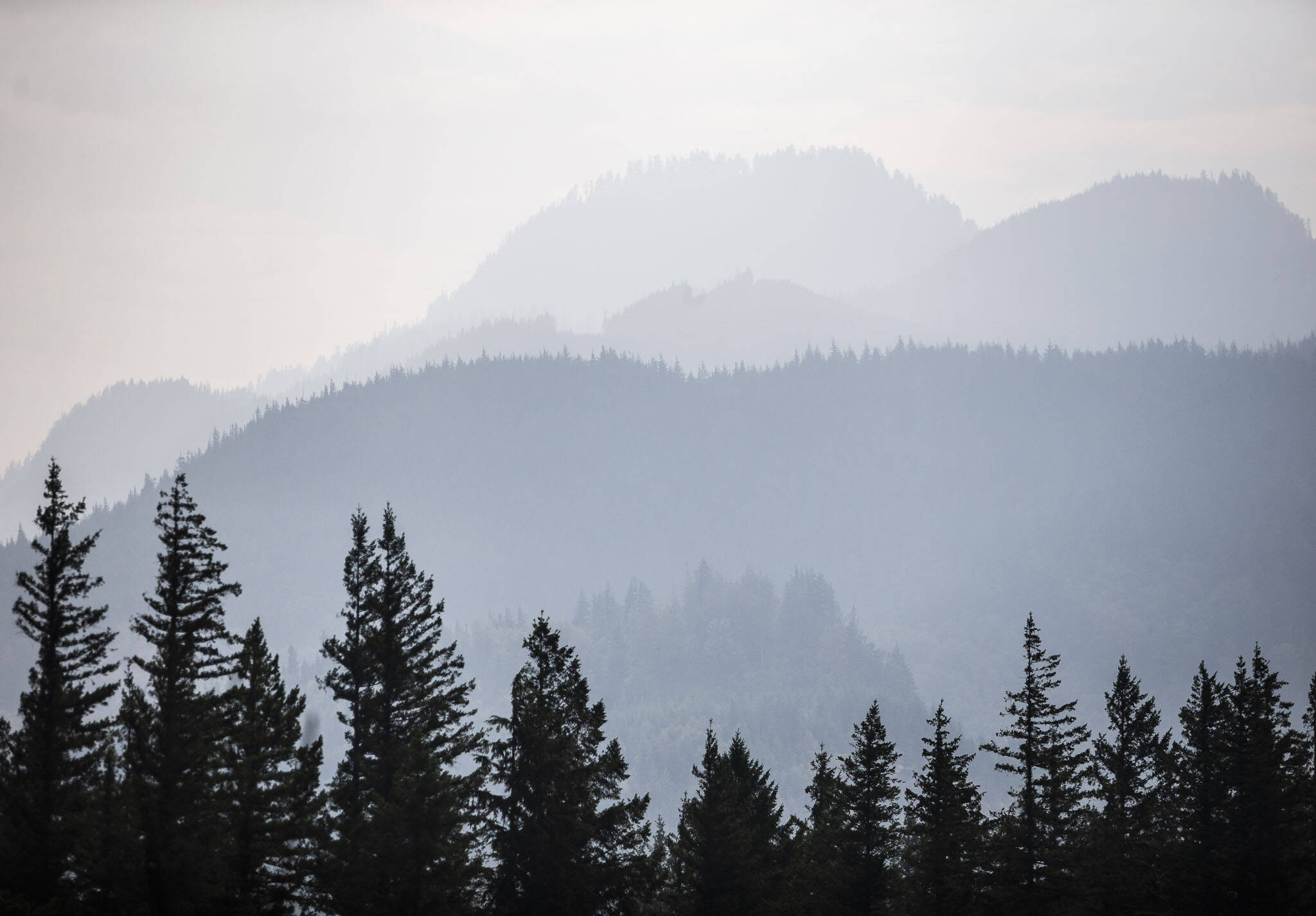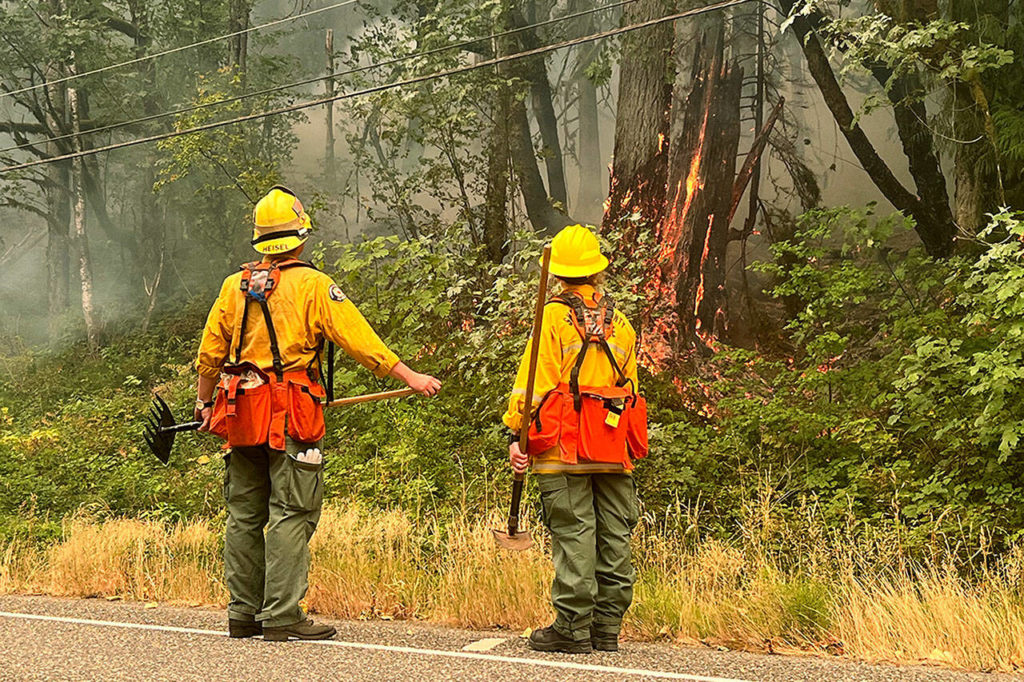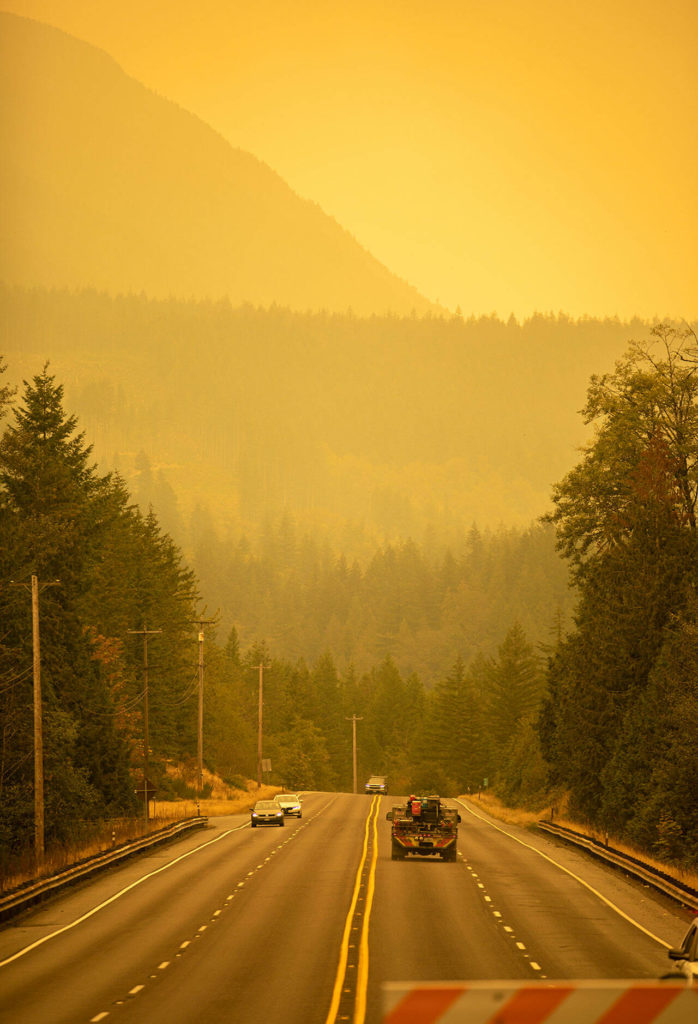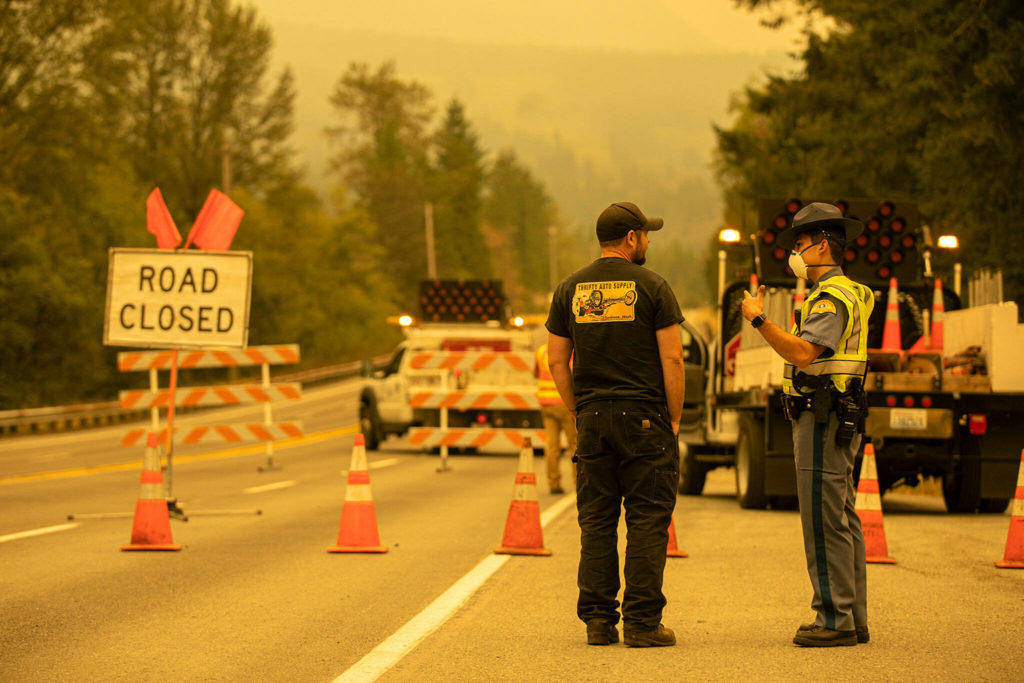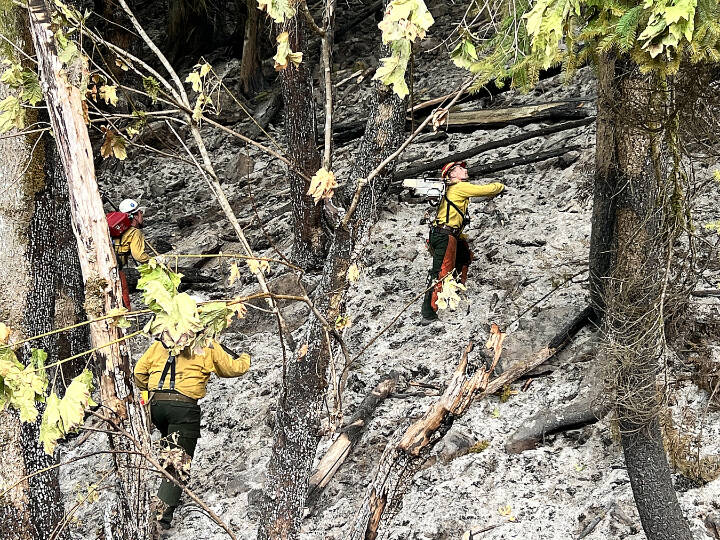INDEX — When the National Weather Service issued a red flag warning for the North Cascades on Sept. 9, it was an “uh-oh” moment for Crystal Raymond, a climate adaptation specialist at the University of Washington.
High winds were bringing hot air from the east instead of moist air from the west. Alarm bells sounded for Raymond and other fire experts.
“It was the exact recipe for a fire: a long, dry summer followed by an east-wind event,” she said. “Given the conditions, we’re very lucky that the temperature dropped and a little bit of rain came in. If we had gotten this red flag warning five to eight days earlier …” she added, trailing off.
Dry conditions are especially worrisome at night. The Bolt Creek wildfire was first spotted at 5:15 a.m. Sept. 10. As the day warmed, the wildfire doubled in size, then doubled again. Ash sprinkled from the sky across Puget Sound, blanketing car windshields. Longtime Washingtonians likened it to the falling ash in the 1980 eruption of Mount St. Helens.
As part of the UW Climate Impacts Group team, Raymond studies how weather and climate influence fires in Western Washington’s famously wet forests.
While climate change tips the scale in favor of fire, Raymond said, the region’s growing population is also putting more people at risk. Newcomers might not realize wildfire is a real danger.
“A large wildfire on the west side is a little bit like an earthquake,” Raymond said. “It could be pretty severe. It’s pretty rare. We need to practice for it because we don’t know how it’s going to go down.”
‘A different animal’
The high temperature at Sea-Tac International Airport has hit 90 degrees or higher 13 times this year, the most in a single year since at least 1945, when data collection began there. And across the entire state of Washington, the July to August time period this year was the warmest on record.
Like other fire experts, Raymond encourages property owners to clear vegetation from around buildings. But clearing brush with prescribed burns and thinning the trees by logging — both techniques used in the sparser woods of Eastern Washington — aren’t going to stave off a big fire, she said.
“There is just so much vegetation, so much fuel,” she said. “These are just naturally dense forests.”
For scientists, a wildfire like Bolt Creek was predictable.
“It seems that we’re getting better, collectively, at knowing when a west-side fire event is likely to happen or is at least quite possible,” said Daniel Donato, a state Department of Natural Resources scientist.
Fires west of the Cascades are weather-driven, requiring a “rare alignment” of conditions, he said.
The presence of an ignition source, late-summer dry conditions and a wind event are the three ingredients needed for a west-side wildfire.
Climate change doesn’t appear to be changing wind patterns, Donato said. But it’s making for longer, hotter summers.
“The increase in the warm, dry conditions loads the dice in that three-part equation,” Donato said, “by increasing the chance that when a wind event occurs, it will meet warm, dry conditions.”
It’s tricky to attribute climate change signals to any individual fire, Donato said. Forests on the east side tend to be more “fuel-limited,” meaning their vegetation is less dense due to the dry climate. But west of the Cascades, scientists say, wildfires are a “different animal.”
The Bolt Creek wildfire’s cause remained under investigation this week. Scientists said it’s unlikely it was caused by lightning.
When wildfires erupt, talk often circulates that forest management made the fire worse, Donato said. Some blame excessive forest management, others blame too little management.
“The truth is probably that neither one of those is the case,” Donato said. “It is a landscape that carries fire regardless of most of the forest management we’ve done. Every forest stage has plenty of fuel to carry fire on the west side.”
‘Will the forest come back?’
From a human standpoint, wildfires can be frightening. They threaten the loss of life and damage to structures. But fires are part of the forest’s life cycle.
“For the most part, what seem like very dramatic events to us are kind of business-as-usual for these ecosystems,” Donato said. “The Bolt Creek fire was very much an event that ecosystem can take in stride.”
After a big fire, DNR scientists often hear people ask: “Will the forest come back?”
The answer is yes. But it will take time, Donato said.
“That difference between the human perspective on these fires and the ecosystem perspective will be relevant for decades in that Bolt Creek footprint,” he said. “Every time people drive by there, it will be an obvious thing that happened. It will look visually dramatic for decades.”
For millennia, wildfires have burned forests on the west side. Tree ring records in the North Cascades show evidence of “enormous” fire events from 300 to 500 years ago, Donato said, where hundreds of thousands of acres burned at once. Fire resets forest growth, making room for more diverse organisms to flourish.
“Right now, a lot of our west-side forests are fairly homogeneous,” Donato said, “due to a legacy of how we’ve managed many forests in the past and how we continue managing forests.”
The rarest habitat condition found in forests in the Cascades is called “preforest,” the condition immediately following a fire where there is an abundance of snags, downed wood, ferns and grasses. Preforest is also one of the most biodiverse habitats found in the region.
The ecosystem that burned near Bolt Creek was a common one in the Cascades, in terms of it being a largely middle-aged forest. Scientists said the fire’s footprint and new preforest growth could be a “net positive” for the mountain landscape, making way for more diverse species.
Some residents voiced concern over the Bolt Creek wildfire’s potential impact on forest-dwelling animals.
Displaced wildlife from a fire of this size generally have not been a major issue, Donato said.
“Not to say there’s no displacement — there’s probably some,” Donato said. “But there’s a big landscape around it that accommodates most of the animals that are in what’s now the burn footprint.”
From a scientific perspective, it’s valuable for people to “zoom out” from the wildfire and see it as part of a bigger landscape, over a broad time period, said DNR scientist Joshua Halofsky.
“Our human memory and lifespan isn’t long enough to encapsulate the frequency of these events,” Halofsky added.
Donato and Halofsky have researched forest regrowth following other wildfires west of the Cascades, including the Norse Peak fire of 2017 that burned over 20,000 acres on the north side of Highway 410, northeast of Mount Rainier National Park. Other examples of recent wildfires in the region include the 6,700-acre Goodell Creek Fire of 2015 and the 24,100-acre Big Hollow Fire of 2020.
“What’s impressive and amazing to us is that, by and large, we are seeing these forests come back,” Halofsky said. “You’re starting to see the herbaceous community come back, and you’re starting to see tree regeneration already.”
‘Replant and start all over’
Two parcels of land owned by the Tulalip Tribes — totaling roughly 1,000 acres — are near the area burning in the Bolt Creek wildfire, said Jason Gobin, fish and wildlife director for the tribes.
The Tulalip Tribes purchased the Grotto Lake and Eagle Creek properties in 2019, “in efforts to allow a safe and sacred area for tribal members to harvest berries, pull cedar, camp, hike, hunt, collect resources for cultural arts and hold cultural practices.”
Gobin said he and others are waiting to get clearance to visit the properties and assess the damage.
“We’re hoping to get up there within the next week or so,” Gobin said. “It’s a disappointment. I guess we’re going to have to replant and start all over again.”
Huckleberry bushes growing in one area might need to be replanted, along with Douglas fir and hemlock trees.
“It was an enticing piece of land because of its proximity to Tulalip and its relation to our Coast Salish ancestors,” reads a Tulalip News story. “Along with that, because of the drastic levels of elevations, the parcels’ vegetation grew many different variations of natural resources that tribal members could collect and utilize.”
When the fire calms down, Snohomish Conservation District workers plan to support those with burned land.
“If people have questions about forests and fire risk protections, they are more than welcome to reach out to our district,” said Stacey Dixon, a conservation district forester. “We can provide them with advice for their property.”
The conservation district has a list of tips on its website for property owners preparing for wildfires in the future. Among the suggestions, authorities urged people to make their properties accessible to first-responders: “Identify your home and neighborhood with legible and clearly marked street names and numbers. Make sure your driveway is at least 12 feet wide with a vertical clearance of 15 feet and a slope of less than five percent to provide adequate access for emergency vehicles.”
The Bolt Creek wildfire’s footprint will be a unique place for the public to research a diverse landscape that will grow in the next decade, Halofsky said. He added that DNR recognizes the fire has affected the land and humans.
Moving forward, Halofsky suggested people look into the recently created King County Wildfire Risk Reduction Strategy as a way to prepare locally. The strategy notes that more than 350,000 people — about 15% of King County’s population — live in the wildland-urban interface, or areas where people and infrastructure are at greater risk of wildfire.
“That strategy is a great example of recognizing that wildfires are a west-side issue,” the scientist said, “and that there are ways we can try to foster resilience and mitigate them when they occur, just like we do for other natural disturbances.”
Ellen Dennis: 425-339-3486; ellen.dennis@heraldnet.com; Twitter: @reporterellen.
Julie Titone is an Everett writer who can be reached at julietitone@icloud.com. Her stories are supported by the Herald’s Environmental and Climate Reporting Fund.
Talk to us
> Give us your news tips.
> Send us a letter to the editor.
> More Herald contact information.
